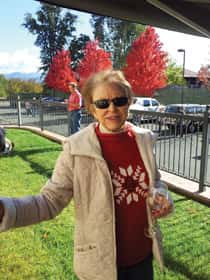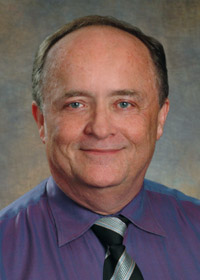Progress is slowly being made against the onset of Alzheimer’s disease, with the discovery of new drug treatments as well as more natural methods of prevention.
 Jeri was born in Oklahoma in 1921, but she’s lived in the North Bay for most of her life. She was married and had two children—a daughter, Toni, and son, Jim. Today, at age 94, Jeri is neatly petite, favors sporty clothes and is all about family. She’s one of five million Americans living with Alzheimer’s disease. And while it may seem to those who encounter her that she’s living behind a veil that’s difficult to slip into, she is living. She lives in the moment, like most Alzheimer’s patients and their families do.
Jeri was born in Oklahoma in 1921, but she’s lived in the North Bay for most of her life. She was married and had two children—a daughter, Toni, and son, Jim. Today, at age 94, Jeri is neatly petite, favors sporty clothes and is all about family. She’s one of five million Americans living with Alzheimer’s disease. And while it may seem to those who encounter her that she’s living behind a veil that’s difficult to slip into, she is living. She lives in the moment, like most Alzheimer’s patients and their families do.When she was younger, Jeri loved to go for walks, bowl and attend church, says Toni, who lives in Santa Rosa. “She loved spending time with friends and family. She enjoyed a good joke and was quick to laugh.” Toni still recalls her mother’s former self with a smile, saying, “She used to take me [as a young girl] to Woolworth’s for hot fudge sundaes. When I was a teenager, my best friend, Linda, would smuggle a mini-skirt to my house and change before heading to school,” she adds, because Linda’s parents were strict on that matter, but Jeri let it slide. “Mom was fun and cool, and she let us wear what we wanted.”
During her 70s, Jeri was living in Napa when Toni noticed her mother was slipping. It became clear in the details of her everyday life. “Her home wasn’t as neat as usual,” says Toni. “And she misplaced the silverware, but we later found it in the lower drawer in the kitchen, covered with paper towels.” Jeri forgot how to vacuum and began stuffing clothes and jewelry between the cushions of her sofa because she was certain people were stealing from her. The incidents continued to escalate and, in the early days even Jeri knew her memory was slipping. Says Toni, “There were moments when she was clear enough to know she wasn’t always clear.”
A physician at Kaiser Permanente diagnosed her with Alzheimer’s disease in 2011. Though the disease was slowly taking its toll, Jeri was able to remain in her home with the help of her boyfriend and family. When she began to wander in her 80s, her care needs incrreased. Toni brought her mom to Santa Rosa to live with her. On her first day in Toni’s home, mother and daughter went wine tasting. For a while, Jeri was engaged again, wore a diamond on her left hand and went on lunch dates with her fiancée. Three years later, as Jeri’s health continued to decline, it became obvious that she required skilled, 24-hour attention. Toni, (who now lives in Pioneer, Calif.), knew it was time to place their mother in a nursing facility, where she lives today.
Jeri’s story is one example of how Alzheimer’s disease can impact a life and a family. While there’s still no cure, health care providers can identify markers earlier with technology today. Although current Alzheimer’s treatments can’t stop the disease from progressing, they can slow dementia symptoms from getting worse and improve the quality of life both for those living with the disease and their caregivers. It’s those small steps of progress that can make a world of difference for everyone touched by the disease.
About Alzheimer’s disease
Alzheimer’s disease was first described in 1906 by Alois Alzheimer, a German physician who linked symptoms to microscopic brain changes in the case of August D., a patient with profound memory loss. Later, a brain autopsy revealed dramatic shrinkage and abnormal deposits in and around nerve cells.
 Alzheimer’s disease is a progressive brain disorder that damages and eventually destroys brain cells, leading to memory loss as well as changes in thinking and other brain functions, according to the Alzheimer’s Association. They usually develop slowly and worsen over time, eventually becoming severe enough to interfere with daily tasks. Symptoms include increasing memory loss (especially forgetting recently learned information), difficulty performing familiar tasks (such as making a phone call), difficulty finding the right words, poor judgment and confusion with time or place, among others. And while personalities don’t change, baseline personalities do come through, says Allan Bernstein, M.D., a neurologist with Sonoma West Medical Center and Healdsburg Hospital. Nice people stay nice, and grumpy people become grumpier.
Alzheimer’s disease is a progressive brain disorder that damages and eventually destroys brain cells, leading to memory loss as well as changes in thinking and other brain functions, according to the Alzheimer’s Association. They usually develop slowly and worsen over time, eventually becoming severe enough to interfere with daily tasks. Symptoms include increasing memory loss (especially forgetting recently learned information), difficulty performing familiar tasks (such as making a phone call), difficulty finding the right words, poor judgment and confusion with time or place, among others. And while personalities don’t change, baseline personalities do come through, says Allan Bernstein, M.D., a neurologist with Sonoma West Medical Center and Healdsburg Hospital. Nice people stay nice, and grumpy people become grumpier.Those with Alzheimer’s disease live an average of eight years after their symptoms become noticeable to others. However, survival can range from four to 20 years, depending on age and other health conditions. Today, Alzheimer’s disease is the sixth leading cause of death in the United States, according to the Alzheimer’s Association.
What causes the disease?
Amyloid plaques are the marker of Alzheimer’s disease. “We don’t know what causes the plaques, but we do know amyloid plaques are found in the brains of people diagnosed with Alzheimer’s disease and are certainly part of the overall process,” says Bernstein.
“Amyloid is a collection of immune proteins in the neuron, displacing all the normal cellular machinery and causing malfunctions,” adds Richard Mendius, M.D., a neurologist with Sutter Pacific Medical Foundation. There are also “tangles,” which cause a different problem. Tangles occur due to a loss of protein in the brain called “tau” (rhymes with “wow”). “When the tau protein becomes dysfunctional, the cell can’t maintain its structure,” he says. And when tau proteins become defective, dementias of the nervous system, such as Alzheimer’s disease, can result.
Can we dissolve the plaque once it’s there? Does inflammation (sparked by the body’s immune system) trigger the disease?
Those are the questions being studied, says Bernstein. “Much like cholesterol, amyloid plaque starts to build up 30 years before symptoms display, but amyloid prevention is tricky because we don’t see it,” he says.
Early detection
Early detection is a key factor in helping people with Alzheimer’s remain independent as long as possible. “It’s good to get people in early and get on medication as fast as you can,” says Mendius. “You want to preserve as much function as possible.”
“We’re better able to identify the biomarkers of probable Alzheimer’s disease using PET imaging and spinal fluid to match up with our clinical exams,” says Bernstein. “We’re able to validate people’s concerns about their memory long before it becomes the disabling condition that we typically associate with that diagnosis. It gives you a window of time for both behavioral changes and a chance for pharmacological intervention to make a meaningful impact. The best outcome for now would be to slow the progression and push the disability aspect out by 10 or more years.”
(PET stands for Positron Emission Tomography; it uses a small amount of radioactive materials called radiotracers, a special camera and a computer to help evaluate organs and tissues. By identifying changes at the cellular level, PET can detect the early onset of diseases such as Alzheimer’s.)
This month, a memory disorder clinic will open in the new Sonoma West Medical Center (formerly Palm Drive Hospital) in Sebastopol. Most people know when their memory is starting to slip, says Bernstein, though friends and family closest to them often don’t notice it at first. “But that’s the stage you want to pick it up,” he says. The clinic will offer an assessment; part of which is to discern whether other factors are causing problems such as depression, too many prescription medications, alcohol abuse or a sleep disorder such as sleep apnea.

“These are the ‘fixables.’ But if you wait too long, the ‘fixables’ become unfixable,” he says.
Determining the stage of the disease is also important. Clinicians at Kaiser Permanente are developing a model of dementia care to improve the quality of care provided to patients and their caregivers according to Wynnelena Canio, M.D., who specializes in geriatric medicine at Kaiser Permanente. The goal is to improve the quality of disease management.
Preserving memory
The earlier you can identify the problem, the better for patients and their families. “For people in the mild stages of Alzheimer’s disease, there’s some evidence that we might delay progression with exercise and mental and social stimulation,” says Canio.
What preserves memory? The goal is to continually stimulate your brain by flooding your senses and interacting socially, according to Bernstein. “When you have a constant flow of information coming in, you’re activating the system,” he says. “There are a number of neurons dying due to normal aging. If you can increase the number of connections in the remaining neurons, you may minimize the aging effect to a great extent. That’s where stimulating your brain becomes both a prevention strategy and a therapeutic modality.”
How do you do that? “When I tell people to exercise, I say go for a walk outdoors and take in the sights and sounds,” Bernstein adds. “That’s multisensory input; different than being on a stationary bike and watching a video. Paying attention to your environment is critical to making new memories,” he adds. “I let people know that changing their behavior does makes a difference," Bernstein continues. “The answer is to look at what you can change.”
Alzheimer’s disease, like other chronic conditions, develops as a result of complex interactions of other multiple factors such as age, genetics, the environment, lifestyle and other medical conditions, according to the Alzheimer’s Association.
“When we study identical twins, they may both get the disease, but it’s not absolute,” says Bernstein. “Everyone has a risk of getting Alzheimer’s disease if we live to 140, but some get it earlier. The goal is to reduce the risk factors.”
What are some of the risk factors? Overindulging in alcoholic beverages, smoking and repeated head injuries, says Bernstein. “Boxers tend to get dementia,” he says.
Head trauma and behaviors that increase the risk of injury to the brain can result in dementia, adds Mendius; this includes sports such as soccer, football and biking without a helmet.
Though the prevalence of Alzheimer’s disease is increasing, there’s evidence that it’s declining in high-income countries, an outcome that’s attributed to education and cardiovascular health, says Canio. There may be much to learn from other countries. Case in point: India has one of the world’s lowest rates of Alzheimer’s disease, she says. Could that be directly correlated to the country’s high consumption of turmeric? There have been a number of studies on the subject. (See “Pass the Turmeric, Please” below.)
“Vascular dementia is relatively preventable. That’s where diet, exercise and stress management can make a difference,” says Bernstein. “We don’t see vascular dementia as much anymore because of our aggressive treatment of high blood pressure, high cholesterol and anti-smoking campaigns.”
As for Alzheimer’s disease, we don’t know exactly whether it’s preventable, he adds. “The most important strategy: take care of your heart and take care of your brain.” (See “Prevention Strategies” below.)
Promising new drugs
 One way to slow the progression of the disease is through medication. Currently, prescription drugs such as Aricept, Exelon and Razadyne are designed to keep neurons functioning, but don’t reverse existing or prevent progressive damage, according to Mendius.
One way to slow the progression of the disease is through medication. Currently, prescription drugs such as Aricept, Exelon and Razadyne are designed to keep neurons functioning, but don’t reverse existing or prevent progressive damage, according to Mendius.“The goal of newer drugs is to reduce the burden of amyloid plaque in the brain, and there are a number of promising treatments for Alzheimer’s disease,” says Bernstein.
A clinical trial, which began in July, is in progress at St. Joseph Health. A new Alzheimer’s drug, Aducanumab, is an experimental monoclonal antibody drug from Biogen, a biotechnology company based in Massachusetts. The drug offers an innovative treatment that may significantly reduce cognitive decline and potentially damaging beta amyloid in the brains of patients with early and mild onset Alzheimer’s disease. “It’s one of the most promising treatments we’ve seen for people in early stages of the illness,” says Bernstein, the principal investigator of research for the drug in Sonoma County.
(If you know someone who may qualify to participate in the clinical trial of Aducanumab, call Research Coordinator Terry Hess at 707-521-3830.)
Care options
The best care option is to keep loved ones with Alzheimer’s disease at home for as long as is practical. “We try to aim for the highest level of independence for everyone,” says Canio. If the goal is to stay at home, she says, Kaiser Permanente provides education and training to caregivers at its Center for Memory Care in Santa Rosa. However, the health of the caregiver is critical, adds Bernstein. When caregiving becomes too burdensome, he says, then it’s time to look for assistance.
Caregivers frequently report having high stress levels, according to the Alzheimer’s Association. Some of the symptoms of caregiver stress include depression, exhaustion, sleeplessness, lack of concentration and other problems. “The morbidity and mortality for the caregiver is as significant as having heart disease or cancer,” says Mendius. Last year, Alzheimer’s and dementia caregivers had $9.7 billion in additional health care costs of their own, according to the Alzheimer’s Association.
It’s important for caregivers to take a break and take advantage of respite care and adult day care programs in the community, says Canio. “Respite care allows temporary relief for the caregiver and helps patients develop friendships and social skills,” she says. Typically, respite care provides 24-hour care when the caregiver needs a break, goes on vacation or has holiday plans.
Full-time assisted living is costly and reserved for Alzheimer’s patients who are unsafe. There are a number of options in the area for day care, respite care and assisted living. (See “Care Options and Resources,” below.)
On the threshold of hope
Though she’s a faded version of her former self, Jeri still finds joy in simple pleasures. She enjoys visits from her children at the nursing facility in Santa Rosa where she lives. She still appreciates a good joke and laugh. Last year, Jeri had the opportunity to meet her great-granddaughter, Juno, who was five months old and visiting from Japan with her parents, Ethan (Jeri’s grandson), and his wife, Yoko.
The impact of Alzheimer’s is devastating, but what medical scientists understand about the disease today—new pharmaceutical treatments and prevention strategies—places health care on the threshold of hope.
“We’re still on the learning curve,” says Bernstein. “In the future, we’ll be better at early diagnosis and slowing the progression of the disease, so we can preserve function and improve quality of life.”
“We’re getting into a level of knowledge about the process of the disease and targeting drugs to remove the plaque and tangles,” adds Mendius. “It’s an interesting time. [The] new drugs may be designed to get closer to the process of reversing the disease.”
As for families touched by Alzheimer’s disease, there’s a gift in the experience. Toni learned the power of patience and love. She knows first-hand how important it is not to make off-the-cuff judgments of the people you encounter in life, whose behavior you may find troubling. Says Toni, “We can never know, mentally or physically, exactly where a person is coming from. So don’t be too quick too judge.”
While there’s still hope for a cure, patients like Jeri are still engaged in life. “I learn from my patients every day,” says Canio, “They’re living in the moment and still loving and laughing and feeling joy.”
Did You Know?
Alzheimer’s disease is the most common form of dementia, according to the Alzheimer’s Association. However, it’s not a normal part of aging, though the greatest known risk factor is increasing age. The majority of people with Alzheimer’s disease are 65 and older. Up to 5 percent of people with the disease have what’s known as “younger-onset,” which often appears when someone is in their late 40s or 50s. In 2015, Alzheimer’s disease and other dementias will cost the nation $226 billion, according to the Alzheimer’s Association.
Prevention Strategies
If you have a healthy heart, chances are your brain is healthy, too¾that’s the main message from North Bay physicians. Here are their key recommendations for preventing vascular dementia and, possibly, Alzheimer’s disease.
• Exercise most days of the week. Aim for at least 30 minutes of aerobic activity such as walking, cycling or swimming. Break it up twice a day, if that’s easier. Try brisk walking 20 minutes in the morning and another 20 minutes in the evening, for example.
• Eat Mediterranean style. That means eating a mostly plant-based diet of fruits and vegetables, whole grains and legumes. Learn to love hummus. Eat fish and poultry; limit red meat. Replace butter with olive oil. And yes, you can drink red wine in moderation.
• Check your medicine cabinet. Most seniors are taking 10 different drugs, says Dr. Allan Bernstein, a neurologist with Sonoma West Medical Center and Healdsburg Hospital, and they’re often not needed. Pain medications are good, but too many interfere with taking in new information. Talk with your doctor to see if you can cut back on the medications you take. If you’re taking Benadryl for allergies or as a sleep aid routinely, limit use or stop taking it altogether, says Dr. Wynnelena Canio, M.D., who specializes in geriatric medicine at Kaiser Permanente. A recent study published in JAMA by a team led by Shelley Gray, a pharmacist at the University of Washington, revealed that people who took medications with anticholinergic properties (such as Benadryl) for three or more years were associated with a 54 percent higher dementia risk than taking the same dose for three months or less.
• Challenge your brain and socialize. Learn a new skill or take a class in a subject you know nothing about. Play cards with your friends, read a book, take up dancing or start painting. Try the computer game Lumosity, which was developed by a team of neuroscientists. The goal is to fire up those neurons in your brain.
• Learn how to manage stress. Meditation and yoga are good ways to quiet your mind and de-stress.
Pass the Turmeric, Please
 Turmeric is one particularly promising spice often found in curries and other dishes from India, Asia and the Middle East. One of the components in turmeric, curcumin, is a strong anti-inflammatory.
Turmeric is one particularly promising spice often found in curries and other dishes from India, Asia and the Middle East. One of the components in turmeric, curcumin, is a strong anti-inflammatory.In 2012, a study published in AYU, An International Quarterly Journal of Research in Ayurveda, reported on three Alzheimer’s patients exhibiting irritability, anxiety and agitation among other symptoms. Findings indicated that behavioral issues had improved significantly after being treated with less than a gram of turmeric daily for three months. Several years ago, ethnobotanist James A. Duke, Ph.D., published a comprehensive summary of more than 700 turmeric studies that supported the Ayurveda research. The spicy antidote was found to counteract symptoms of Alzheimer’s disease by blocking the formation of beta-amyloid, the sticky protein substance believed to have a hand in the degeneration of healthy brain tissue.
Care Options and Resources
There are a number of care options for families coping with Alzheimer’s disease in the North Bay:
• Catholic Charities of the diocese of Santa Rosa offers a licensed day care program for people with dementia;
• Council on Aging offers an adult day program in four different locations, including Sonoma, Healdsburg, Sebastopol and Santa Rosa;
• Healdsburg Senior Living offers assisted living and memory care;
• Petaluma People Services Center offers senior day care and respite care;
• Primrose in Santa Rosa offers adult day care, respite care and assisted living;
• Adobe House in Petaluma offers assisted living care.
• Spring Lake Village offers assisted living and respite care.
• Vintage Brush Creek in Santa Rosa offers independent senior living, assisted living and memory care services.
You can also contact the Redwood Caregiver Resource Center at (707) 542-0282 or (800) 834-1636. The center offers monthly caregiver training classes. The Alzheimer’s Association North Bay offers five early stage support groups for people living with Alzheimer’s disease and their caregivers in Santa Rosa, San Rafael, Napa and Sonoma. Call (707) 573-1210 for more information.
Have questions or concerns? The Alzheimer’s Association helpline is staffed 24 hours a day, seven days per week. Call (800) 272-3900.
Author
-

Karen Hart is the editor of NorthBay biz magazine, keeping her finger on the pulse of the North Bay, directing content and leading day-to-day operations of the editorial team. An award-winning writer, Karen brings more than 30 years of experience to the position. She is a member of the California Writers Club, and serves on the Journalism Advisory Council at Santa Rosa Junior College. She moved to Sonoma County in 2000, and she’s here to stay.
View all posts



